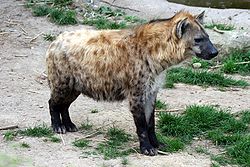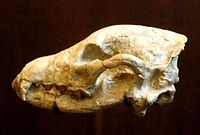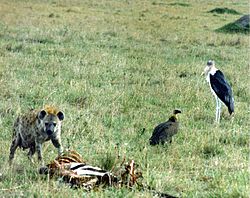
Hyena
Background Information
The articles in this Schools selection have been arranged by curriculum topic thanks to SOS Children volunteers. Do you want to know about sponsoring? See www.sponsorachild.org.uk
| Hyenas Temporal range: Early Miocene to Recent |
|
|---|---|
 |
|
| Spotted Hyena | |
| Scientific classification | |
| Kingdom: | Animalia |
| Phylum: | Chordata |
| Class: | Mammalia |
| Order: | Carnivora |
| Suborder: | Feliformia |
| Family: | Hyaenidae Gray, 1821 |
| Living Genera | |
|
|
| Synonyms | |
|
|
The Hyaenidae is a mammalian family of order Carnivora. The Hyaenidae family, native to both African and Asian continents consists of four living species, the Striped Hyena and Brown Hyena (genus Hyaena), the Spotted Hyena (genus Crocuta) and the Aardwolf (genus Proteles).
Evolution
Hyenas seem to have originated 22 million years ago from arboreal ancestors bearing similarities to the modern Banded Palm Civet. Plioviverrops, one of the earliest hyenas, was a lithe civet-like creature that inhabited Eurasia 20-22 million years ago. Details from the middle ear and dental structure marked it as a primitive hyena. This genus proved successful, its descendants flourishing with more pointed jowels and racier legs, much as the Canidae had done in North America. Fifteen million years ago, dog-like hyenas flourished, with 30 different species being identified. Unlike some of their modern descendants, these hyenas were not specialized bone-crushers, but were more nimble, wolf-like animals. The dog-like hyenas had canid-like molars, allowing them to supplement their carnivorous diet with vegetation and invertebrates.
Five to seven million years ago, the dog-like hyenas were outcompeted by canids traveling from North America to Eurasia via the Bering land bridge. The ancestral aardwolves survived by having adapted themselves to an insectivorous diet to which few canids had specialized. Some hyenas began evolving bone crushing teeth in order to avoid competing with the canids, resulting in the hyenas eventually outcompeting a family of similarly built bone crushers called "percrocutoids". The percrocutoids became extinct 7 million years ago, coinciding exactly with the rise of bone crushing hyena species. Unlike the canids who flourished in the newly colonized Eurasian continent, only one hyena species, the cheetah-like Chasmaporthetes managed to cross to North America. It went extinct 1.5 million years ago.
The peak diversity of the Hyenidae was during the Pleistocene, with 4 genera and 9 species of hyena. The bone crushing hyenas became the Old World's dominant scavengers, managing to take advantage of the amount of meat left over from the kills of sabre-toothed cats. One such species was Pachycrocuta, a up 200 kg (440 lb) mega-scavenger that could crush elephant bones. As the sabre-toothed cats began to die out and be replaced by short-fanged felids which were more efficient eaters, more hyenas began to hunt for themselves and began evolving into new species, the modern spotted hyena being among them.
Genera of the Hyaenidae (extinct and recent)
The list follows McKenna and Bells Classification of Mammals for prehistoric genera (1997) and Wozencraft (2005) in Wilson and Reeders Mammal Species of the World for extant genera . The Percrocutids are in contrast to McKenna and Bells classification not included as a subfamily into the Hyaenidae but as a separate family Percrocutidae. Furthermore, the genus Paracrocuta, to which the living brown hyena belongs, is not included into the genus Pachycrocuta but in the genus Hyaena. The Protelinae (Aardwolves) are not traded as a separate subfamily but included in the Hyaeninae.
- Family Hyaenidae
-
- † Tongxinictis (Middle Miocene of Asia)
- †Subfamily Ictitheriinae
- † Herpestides (Early Miocene of Africa and Eurasia)
- † Plioviverrops (including Jordanictis, Protoviverrops, Mesoviverrops; Early Miocene to Early Pliocene of Europe, Late Miocene of Asia)
- † Ictitherium (=Galeotherium; including Lepthyaena, Sinictitherium, Paraictitherium; Middle Miocene of Africa, Late Miocene to Early Pliocene of Eurasia)
- † Thalassictis (including Palhyaena, Miohyaena, Hyaenictitherium, Hyaenalopex; Middle to Late Miocene of Asia, Late Miocene of Africa and Europe)
- † Hyaenotherium (Late Miocene to ?Early Pliocene of Eurasia)
- † Miohyaenotherium (Late Miocene of Europe)
- † Lychyaena (Late Miocene of Eurasia)
- † Tungurictis (Middle Miocene of Africa and Eurasia)
- † Proictitherium (Middle Miocene of Africa and Asia, Middle to Late Miocene of Europe)
- Subfamily Hyaeninae
- † Palinhyaena (Late Miocene of Asia)
- † Ikelohyaena (Early Pliocene of Africa)
- Hyaena (=Euhyaena, =Hyena; including Parahyaena, Pliohyaena, Pliocrocuta, Anomalopithecus) Early Pliocene (?Middle Miocene) to Recent of Africa, Late Pliocene (?Late Miocene) to Late Pleistocene of Eurasia)
- † Hyaenictis (Late Miocene of Asia?, Late Miocene of Europe, Early Pliocene (?Early Pleistocene) of Africa)
- † Leecyaena (Late Miocene and/or Early Pliocene of Asia)
- † Chasmaporthetes (=Ailuriaena; including Lycaenops, Euryboas; Late Miocene to Early Pleistocene of Eurasia, Early Pliocene to Late pliocene or Early Pleistocene of Africa, Late Pliocene to Early Pleistocene of North America)
- † Pachycrocuta (Pliocene and Pleistocene of Eurasia and Africa)
- † Adcrocuta (Late Miocene of Eurasia)
- Crocuta (=Crocotta; including Eucrocuta; Late Pliocene to recent of Africa, Late Pliocene to Late Pleistocene of Eurasia)
- Proteles (=Geocyon; Pleistocene to Recent of Africa)
-
Appearance & Biology
Although hyenas bear some physical resemblance to canids, they make up a separate biological family that is most closely related to Herpestidae (the family of mongooses and meerkats), thereby falling within the Feliformia. All species have a distinctly bear-like gait due to their front legs being longer than their back legs. The Aardwolf, Striped Hyena and Brown Hyena have striped pelts and manes lining the top of their necks which erect when frightened. The Spotted Hyena's fur is considerably shorter and spotted rather than striped. Unlike other species, its mane is reversed forwards.
Spotted Hyenas and, to a lesser extent, Striped and Brown Hyenas, have powerful carnassial teeth adapted for cutting flesh and premolars for crushing bone. Spotted hyenas have a strong bite proportional to their size, but the view that they have the strongest bite is a myth; and a number of other animals (including the Tasmanian devil) are proportionately stronger. The Aardwolf has greatly reduced cheek teeth, sometimes absent in the adult, but otherwise has the same dentition as the other three species. The dental formula for all hyena species is:
| Dentition |
|---|
| 3.1.4.1 |
| 3.1.3.1 |
Labiolingually, their mandibles are much stronger at the canine teeth than in canids, reflecting the fact that hyenas crack bones with both their anterior dentition and premolars, unlike canids which do so with their post-carnassial molars. Like felids, hyenas lack the rearward molars of canids and vivverids. By organising their teeth so that the bone-crushing premolars do not interfere with the meat-slicing carnassials to the rear, hyenas can crush bone without blunting the carnassials' blades.
Hyenas, in particular the spotted hyena, are highly intelligent animals, with some studies strongly suggesting convergent evolution in hyena and primate intelligence. Spotted hyena societies are more complex than those of other carnivorous mammals, and have been reported to be remarkably similar to those cercopithecine primates in respect to group size, structure, competition and cooperation. One indication of hyena intelligence is that they will move their kills closer to each other to protect them from scavengers; another indication is their strategic hunting methods.
The majority of hyena species show little sexual dimorphism, usually with males being only slightly larger than the females. The spotted hyena is an exception to this as females are larger than the males. One unusual feature of the spotted hyena is that females have an enlarged clitoris called a pseudo-penis, demi-penis or sometimes mistakenly referred to as a nanophallus. Female hyenas give birth, copulate, and urinate through their protruding genitalia, which stretches to allow the male penis to enter for copulation, and it also stretches during birth. The anatomical position of the genitalia gives females total sexual control over who is allowed to mate with them. Researchers originally thought that one cause of this characteristic of the genitals was androgens that were introduced to the fetus very early on in its development. However, it was discovered that when the androgens were held back from the fetus, the development of the female genitalia was not altered.
All species excrete an oily, yellow substance from their anal glands onto objects to mark their territories. When scent marking, the anal pouch is turned inside out, or everted. Hyenas also do this as a submissive posture to more dominant hyenas. Genitals, the anal area, and the anal glands are sniffed during greeting ceremonies in which each hyena lifts its leg and allows the other to sniff its anal sacks and genitals. All four species maintain latrines far from the main denning area where dung is deposited. Scent marking is also done by scraping the ground with the paws, which deposits scent from glands on the bottoms of the feet. Hyenas do not raise their legs when urinating as male or dominant canids do.
Unlike the canids, hyenas do not regurgitate or carry back food for their young, due to the speed with which the food is digested.
Habitat
With the exception of the Striped Hyena which has been seen in the jungles of India, all modern Hyena species generally reside in arid environments like African savannahs and deserts.
Dietary habits
Except for the Aardwolf, all hyena species are efficient hunters and scavengers. They have extremely strong jaws in relation to their body size and have a very powerful digestive system with highly acidic fluids, making them capable of eating and digesting their entire prey, including skin, teeth, horns, bones . Hair and hooves are usually regurgitated. Since they have no aversion to and readily eat carrion, their digestive system deals very well with bacteria.
The spotted hyena is primarily a predator, unlike some of its cousins. Spotted hyenas are successful pack hunters of small to large sized ungulates and are the most abundant carnivore on the African continent.
The Aardwolf is a specialised feeder of termites, thus lacking the size and physical power of its cousins.
In culture

Negative associations have generally stemmed from Hyenas' tendency to scavenge graves for food. They are one of the few creatures naturally suited for this due to their ability to devour and digest every part of a carcass, including bone. As such, many associate hyenas with gluttony, uncleanliness, and cowardice.
The haunting laughter-like calls of the spotted hyena inspired the idea in local cultures that they could imitate human voices and call their victims by name. Hyenas are also associated with divination and sometimes thought of as tools of demons and witches. In African folklore, witches and sorcerers are thought to ride hyenas, or even turn into them.
African attitudes toward hyenas are little better than those held in the European cultures. The Bouda is a mythical tribe reputed to house members able to transform into hyenas. Belief in " Werehyenas" is so entrenched within the traditional lore of the Bornu people of north-eastern Nigeria, that their language even contains a special word bultungin which translates as "I change myself into a hyena".
Early naturalists thought hyenas were hermaphrodites or commonly practiced homosexuality, largely due to the female spotted hyena's unique urogenital system. According to early writings such as Ovid's Metamorphoses and the Physiologus, the hyena continually changed its sex and nature from male to female and back again. In Paedagogus, Clement of Alexandria noted that the hyena (along with the hare) was "quite obsessed with sexual intercourse." Many Europeans associated the hyena with sexual deformity, prostitution, and deviant sexual behaviour.
Hyenas (usually "Laughing Hyenas") have been used in animated movies many times, as well as having been rendered in live action films, commonly cast as hysterical and unhinged villains. Examples include those featured in the Disney animated film The Lion King who are called Shenzi, Banzai and Ed, one ball-playing individual in Bedknobs and Broomsticks, and many more shown in animated films.







